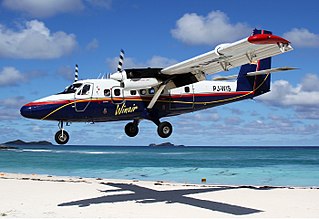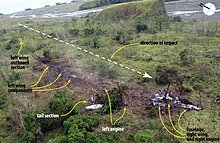
A turboprop is a turbine engine that drives an aircraft propeller.

The De Havilland Canada DHC-8, commonly known as the Dash 8, is a series of turboprop-powered regional airliners, introduced by de Havilland Canada (DHC) in 1984. DHC was bought by Boeing in 1986, then by Bombardier in 1992, then by Longview Aviation Capital in 2019; Longview revived the De Havilland Canada brand. Powered by two Pratt & Whitney Canada PW150s, it was developed from the Dash 7 with improved cruise performance and lower operational costs, but without STOL performance. The Dash 8 was offered in three sizes: the initial Series 100 (1984-2005) and the more powerful Series 200 (1995-2009) with 37-40 seats, the Series 300 (1989-2009) with 50-56 seats, and Series 400 (1999-Present) with 68-90 seats. The QSeries are post-1997 variants fitted with active noise control systems.

The de Havilland Canada DHC-6 Twin Otter is a Canadian STOL utility aircraft developed by de Havilland Canada in the mid-1960s and still in production today. De Havilland Canada produced it from 1965 to 1988; Viking Air purchased the type certificate, then restarted production in 2008 before re-adopting the DHC name in 2022. In 2023 DHC restarted production of the 300 series, in addition to the Series 400 produced by Viking. The aircraft's fixed tricycle undercarriage, STOL capabilities, twin turboprop engines and high rate of climb have made it a successful commuter airliner, typically seating 18–20 passengers, as well as a cargo and medical evacuation aircraft. In addition, the Twin Otter has been popular with commercial skydiving operations, and is used by the United States Army Parachute Team and the 98th Flying Training Squadron of the United States Air Force.

The de Havilland Canada DHC-3 Otter is a single-engined, high-wing, propeller-driven, short take-off and landing (STOL) aircraft developed by de Havilland Canada. It was conceived to be capable of performing the same roles as the earlier and highly successful Beaver, including as a bush plane, but is overall a larger aircraft.
Air Niugini Limited is the flag carrier of Papua New Guinea, based in Air Niugini House on the site of Port Moresby International Airport, Port Moresby. It operates a domestic network from Port Moresby to 12 major airports while its subsidiary company, Link PNG, operates routes to minor airports. It also operates international services in Asia, Oceania, and Australia on a weekly basis. Its main base is Port Moresby International Airport, which is located in 7 Mile, Port Moresby, Papua New Guinea. Niugini is the Tok Pisin word for New Guinea.

The de Havilland Canada DHC-7, popularly known as the Dash 7, is a turboprop-powered regional airliner with short take-off and landing (STOL) performance. Variants were built with 50–54 seats. It first flew in 1975 and remained in production until 1988 when the parent company, de Havilland Canada, was purchased by Boeing in 1986 and later sold to Bombardier. In 2006 Bombardier sold the type certificate for the aircraft design to Victoria-based manufacturer Viking Air.

Mission Aviation Fellowship (MAF) is a Christian organization that provides aviation, communications, and learning technology services to more than 1,000 Christian and humanitarian agencies, as well as thousands of isolated missionaries and indigenous villagers in the world's most remote areas. There are three major operational centers – Nampa, Idaho; Ashford, England; and Cairns, Australia. These centres provide operational support to programs in the Americas, Africa and Asia Pacific regions. In 2010, MAF served in more than 55 countries, flying 201,710 passengers with a fleet of some 130 aircraft.
PNG Air is an airline based on the grounds of Jacksons International Airport, Port Moresby, Papua New Guinea. It operates scheduled domestic and international flights, as well as contract corporate charter work. Its main base is Jacksons International Airport.

The GAF Nomad is a utility aircraft produced by the Government Aircraft Factories (GAF) of Australia in Melbourne. The twin-turboprop, high-wing aircraft has a retractable gear and came in two variants: the initial N22, followed by the stretched N24. Supported by the Australian Government, design work began in the mid-1960s, and it made its maiden flight on 23 July 1971. Despite some export sales and commercial operations, sales were not sufficient and production stopped in 1985.
Tabubil Airport is an international airport in Tabubil, Papua New Guinea. Asia Pacific Airlines operates out of Tabubil as its hub.

Merpati Nusantara Airlines Flight 9760D was a domestic commercial passenger 50-minutes flight, flying from Sentani Airport in Papua's Province Jayapura to Oksibil Airport in Oksibil, Indonesia operated by a de Havilland Canada DHC-6 Twin Otter 300. On Sunday, August 2, 2009, while carrying fifteen people over Papua, the aircraft went missing en route. Its wreckage was found a few miles from Oksibil two days later. All 12 passengers and 3 crew members were killed in the accident.

Airlines PNG Flight 4684 (CG4682/TOK4684) was a scheduled domestic passenger flight operated by Papua New Guinean airliner Airlines PNG, flying from Jacksons International Airport in Papua New Guinea's capital Port Moresby to Kokoda Airport in Oro Province, Papua New Guinea. On 11 August 2009, the aircraft operating the flight, a de Havilland Canada Twin Otter, crashed into a forest in Kokoda Valley, a popular trekking site in Papua New Guinea, while carrying 13 people in bad weather. A search and rescue operation was conducted by authorities and found the wreckage of the crashed plane on the next day, 12 August 2009. The aircraft was severely damaged, and searchers found no signs of life. Papua New Guinean Search and Rescue Agency then announced that everyone on board was killed instantly in the crash.

Kish Air Flight 7170 was a scheduled international passenger flight from Kish Island in Iran to Sharjah, United Arab Emirates, operated by Iranian airline Kish Air. On February 10, 2004, the aircraft serving the route, a Fokker 50, lost control and crashed onto terrain while on approach to Sharjah International Airport. A total of 43 out of 46 people on board were killed in the crash, making it the deadliest air disaster involving the Fokker 50.

On April 4, 1955, a United Airlines Douglas DC-6 named Mainliner Idaho crashed shortly after taking off from Long Island MacArthur Airport, in Ronkonkoma, Islip, New York, United States.

On 13 April 2016, a Britten-Norman BN-2T Turbine Islander operated by Sunbird Aviation crashed about 1,200 m short of runway 7 at Kiunga Airport in the Western Province of Papua New Guinea. The plane pitched up right before the crash, then dropped its right wing and fell almost vertically to the ground. Eleven passengers and the 31-year-old Australian pilot, Benjamin Picard, were killed. Nine people died on impact, with other three declared dead on arrival at Kiunga Hospital.

On 18 May 2016, a Silk Way Airlines Antonov An-12 cargo plane crashed after an engine failure shortly after taking off from Dwyer Airport in southern Afghanistan, en route to Mary International Airport in Turkmenistan. Seven of the nine crew members on board were killed in the crash, which was the second incident for Silk Way in Afghanistan after a 2011 Il-76 crash. Two others were taken to hospital and treated for their injuries.

Merpati Nusantara Airlines Flight 6517 (MZ6517/MNA6517) was a scheduled domestic passenger flight from Bajawa to Kupang, Indonesia. On 10 June 2013, the Xian MA60 twin turboprop operating the route crashed on the runway while landing at Kupang's El Tari Airport, injuring 25 occupants, five seriously. The aircraft was severely damaged in the impact and subsequently written off.

Pakistan International Airlines Flight 661 was a Pakistani domestic passenger flight from Chitral to Islamabad, operated by Pakistan's flag carrier Pakistan International Airlines. On 7 December 2016, the aircraft serving the route, an ATR 42-500 twin-turboprop, lost control and crashed near Havelian following an engine failure. All 47 people on board died, including singer-turned-preacher and entrepreneur Junaid Jamshed, and the Deputy Commissioner of the District of Chitral.

Air Caraïbes Flight 1501 (TX1501/FWI1501) was a scheduled international passenger flight, flying from Saint Martin Airport in the Dutch overseas territory of Sint Maarten to Saint Barthélemy Airport which was in the French overseas region of Guadeloupe at that time. The flight was operated by Air Caraïbes, a Caribbean regional airline, using a de Havilland Canada DHC-6-300 Twin Otter. On 24 March 2001, during an approach to Saint Barthélemy Airport, the DHC-6 Twin Otter banked steeply to the left and crashed into a house, killing all 19 passengers and crew on board. One person on the ground was also killed in the explosions that followed.
Ansett Airlines of Papua New Guinea was a Papua New Guinea airline and Ansett subsidiary founded in 1936 as Mandated Airlines.


















